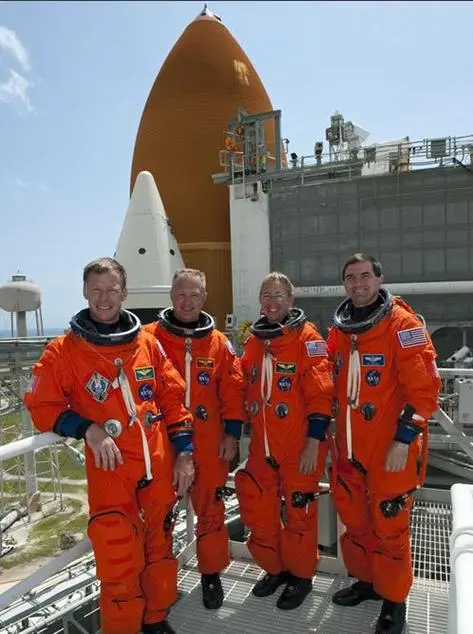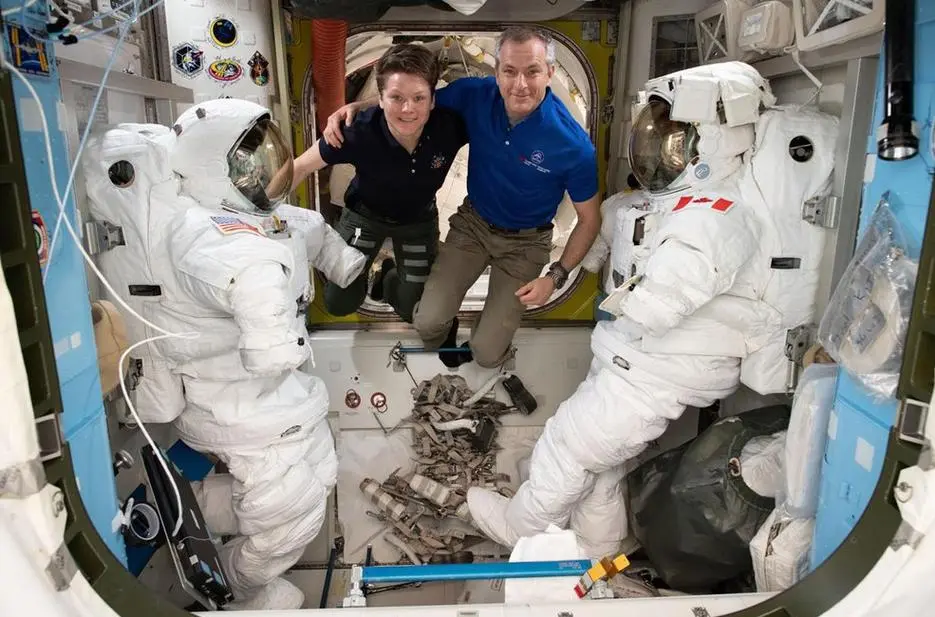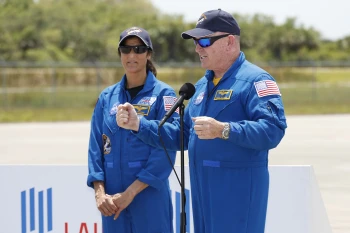The anticipation for Boeing’s first human spaceflight is palpable as NASA astronauts Butch Wilmore and Suni Williams arrived at their launch site in Cape Canaveral, Florida.
With just over a week left before their scheduled liftoff on May 6, the two seasoned astronauts are gearing up to serve as test pilots for Boeing’s Starliner capsule.
The Starliner capsule has faced multiple delays over the years, but now it is finally ready to make its debut with a crew on board.
Wilmore and Williams flew in from Houston to Kennedy Space Center, where they will prepare for their mission to the International Space Station for a weeklong shakedown cruise.
Boeing is playing catch up to SpaceX, which has been successfully launching astronauts for NASA since 2020. The competition between the two aerospace giants has been fierce, with both companies striving to demonstrate their capabilities in human spaceflight.
The road to this moment has been fraught with challenges for Boeing. The previous two test flights of the Starliner capsule were unmanned and encountered various issues, including software glitches and parachute malfunctions.
The team at Boeing has worked tirelessly to address these issues and ensure that the Starliner is ready for its first crewed mission.
Wilmore emphasized the importance of this test flight in uncovering any potential issues that may arise. He acknowledged that perfection is not guaranteed, especially on the first human flight of a spacecraft.
However, he expressed confidence in the team’s preparations and their ability to handle any challenges that may come their way.
As the countdown to liftoff begins, all eyes are on Boeing and the Starliner capsule. The success of this mission will not only mark a significant milestone for Boeing but also for the future of human spaceflight.
With Wilmore and Williams at the helm, the journey to the International Space Station promises to be a thrilling and historic one.
In conclusion, the upcoming launch of Boeing’s Starliner capsule with NASA astronauts on board is a testament to the perseverance and dedication of the teams involved.
Despite the setbacks and challenges along the way, the dream of human spaceflight continues to inspire and push the boundaries of what is possible.
As we look towards the stars, we are reminded of the incredible feats that can be achieved through collaboration, innovation, and a relentless pursuit of exploration.
NASA’s decision to contract SpaceX and Boeing a decade ago for the transportation of astronauts to and from the International Space Station (ISS) marked a significant milestone in the history of space exploration.

The space agency’s strategic partnership with these two prominent aerospace companies not only signaled a shift towards commercial space travel but also underscored NASA’s commitment to fostering innovation and collaboration within the space industry.
Despite the impending closure of the ISS by 2030, NASA remains steadfast in its pursuit of maintaining a diverse fleet of spacecraft, with capsules from multiple providers, to ensure the safety and reliability of crewed missions to space.
The involvement of SpaceX and Boeing in NASA’s crew transportation program represents a convergence of cutting-edge technology, engineering expertise, and operational excellence.
By entrusting these industry leaders with the responsibility of transporting astronauts to the ISS, NASA has demonstrated its confidence in their ability to deliver on the agency’s stringent safety and performance requirements.
The partnership between NASA, SpaceX, and Boeing exemplifies a new era of public-private collaboration in space exploration, where government agencies and commercial entities work hand in hand to push the boundaries of human spaceflight.
The significance of having capsules from two competing companies for NASA’s astronauts cannot be overstated. By maintaining a competitive environment in the commercial crew transportation sector,
NASA is not only fostering innovation and driving down costs but also ensuring redundancy and resilience in its crew transportation capabilities.
The ability to choose between multiple spacecraft providers gives NASA the flexibility to adapt to changing mission requirements, mitigate risks, and maximize the success of crewed space missions.
As NASA prepares for the historic launch of astronauts on an Atlas rocket, a spacecraft that has not been used for crewed missions since the early days of Project Mercury in the 1960s, the agency is once again poised to make history.
The upcoming mission, which will see astronauts Wilmore and Williams embarking on a journey to the ISS aboard the Atlas rocket, symbolizes a continuation of NASA’s legacy of exploration, discovery, and human achievement in space.

In conclusion, NASA’s decision to engage SpaceX and Boeing for crew transportation services underscores the agency’s commitment to innovation, safety, and collaboration in the realm of human spaceflight.
By partnering with industry leaders and maintaining a diverse fleet of spacecraft, NASA is paving the way for a sustainable and vibrant future in space exploration.
The upcoming launch of astronauts on an Atlas rocket represents a significant milestone in NASA’s journey towards the stars and serves as a testament to the agency’s unwavering dedication to pushing the boundaries of human exploration beyond Earth’s confines.
